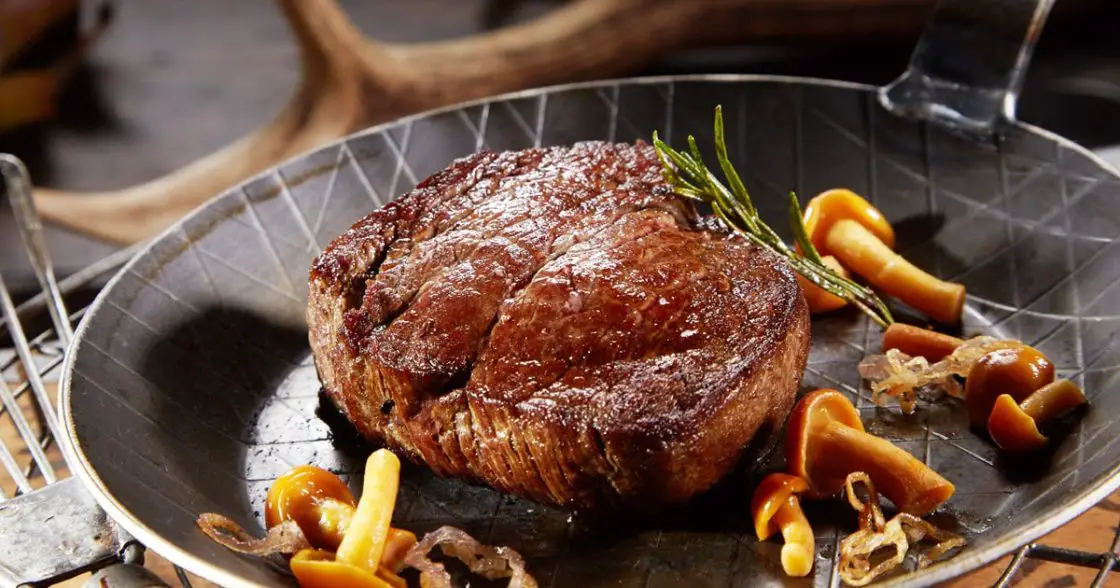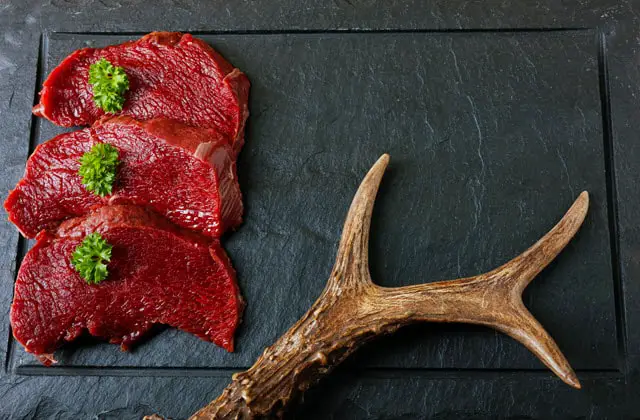While venison usually refers to deer meat, some people also use this term for meat from other kinds of animals, such as antelope (and antelope are actually different from deer). If you’re like many people in the United States, especially in urban and suburban areas, you’ve never tasted venison. If that’s the case and you’re interested in tasting this delicious red meat, there is quite a bit to learn, starting with the obvious: What does venison taste like?
In today’s article we’ll answer that question, and also discuss what you should pair this healthy, high-protein meat with, and much more.
Let’s get started!
So, What Does Venison Taste Like?
If you’ve never eaten game meat, it’s difficult to describe what venison tastes like.
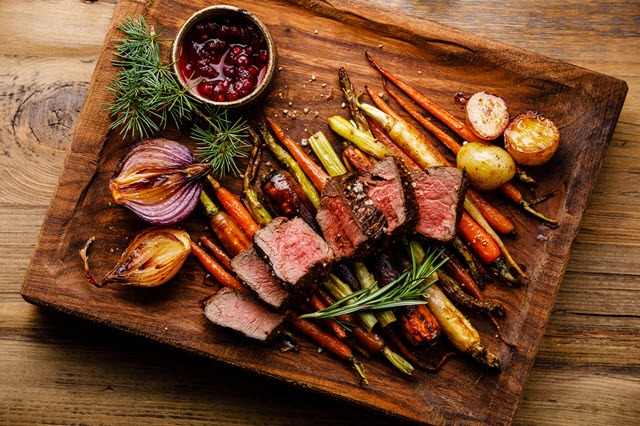
Many people describe venison as tasting earthy and rich. Others even use the word “festive.” Why? It’s because it often has many flavors we associate with the festive holiday season of the year. For example, you may notice faint flavors of herbs, sage, and acorn. The specific flavors you’ll taste in venison will vary depending on the diet of the deer.
In general you may find that:
- Venison has a firmer, chewier texture than beef or other meat from domesticated livestock.
- It is not as juicy as meat from a cow, but most diners find it more flavorful.
- Venison is often compared to Mutton (the meat from an older sheep) in terms of its texture.
- Because of the active lifestyle of wild deer, Venison tends to be more dry, dense, and firm.
- It may taste more or less “gamey” depending upon the method of field dressing used.
More About Venison’s Unique Texture & Flavor Profile
Venison has a firmer texture than beef, but it’s not as juicy. Let’s take a look at the word “gamey.” If your venison has come from a deer that was properly field-dressed, there shouldn’t be an unpleasant level of gamey flavor. There will be enough, however, to make it distinguishable from meat taken from farm-raised animals. If you eat venison from deer raised on a farm, it won’t have a gamey flavor.
Have you ever tried mutton (sheep meat)? Some people find that venison tastes a bit like that meat. Venison is red meat, and it’s extremely nourishing to the human body. It has a taste many describe as “natural.” Remember wild deer live off the natural world, eating all kinds of browse items such as shrubs and twigs. These flavors make their way into the meat.
One of the aspects of venison you might find surprising is its texture. One aspect of this is its relative dryness and firmness when compared to other kinds of meat. But venison’s chewiness can help make it more satisfying to eat. Why is venison so dense? It’s because of their lifestyle. They are extremely active, doing lots of running and walking during the course of their lives.
What Foods Should You Pair with Venison?
Many venison-enthusiasts love pairing this meat with mint and minty flavors. This makes it similar to lamb. It also does well with flavors we associate with the fall, such as certain spices. When deciding on foods to pair with venison, think about the kinds of food you would pair with lamb.
There are certain herbs and spices that do well with venison. Some of these include:
- Sage,
- Rosemary,
- Bay Leaves,
- Juniper Berries,
- Sweet Marjoram, and
- Other Savory Herbs.
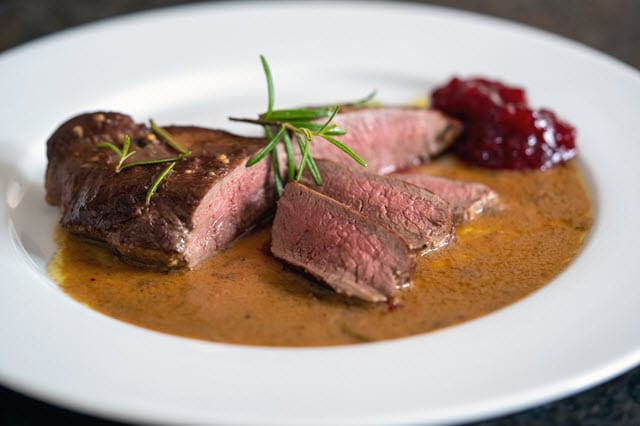
Sage is considered one of the best herbs to use when preparing venison. It’s great at toning down unwanted gaminess. At the same time, however, you’ll still enjoy the full venison flavor. You can use either fresh or dried sage with your deer meat. Start with a little and build up to more if you want to as you learn more about cooking venison.
Rosemary is wonderful for creating a venison with potatoes dish. This herb has enough of its own flavor to perfectly complement venison while allowing the meat to shine. It’s a great addition to a venison recipe if you dislike heaviness. Just like with lamb, use rosemary sprigs on your venison. You can also grind up the sprigs and rub them into the meat.
If you want to use bay leaves with your venison, you’re in for a treat. Many venison-connoisseurs find that bay leaves are the perfect herb for creating more balance in the meat’s flavor. Bay leaves are especially great if you are making a venison stew or soup.
Yet another herb that goes well with venison is juniper berries. This is the recipe addition to use if you enjoy citrus-like flavors. This is what makes it a unique touch. Juniper berries complement venison well, helping to balance out the flavor and adding a new twist. When you look at venison recipes using juniper berries, you’ll notice they probably require you crush the berries before using them.
Pairing Venison with Wine
Don’t forget pairing your venison dinner with a wonderful wine.
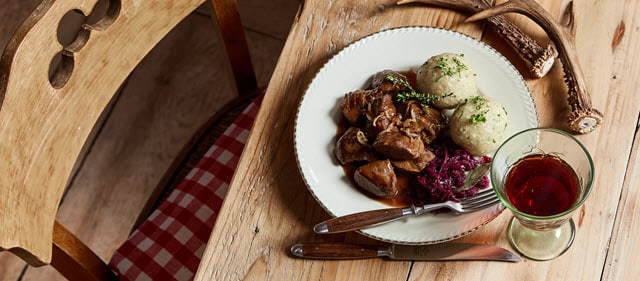
As this is a red meat, most people recommend pairing it with a red wine. Different people have their own opinions on what kinds of wine go best with venison, bringing out its flavors in the most memorable way. Look for a wine that brings out the fruity flavors in venison.
Some examples of wines you may enjoy accompanying a venison dinner include:
- Shiraz,
- Merlot,
- Cabernet Sauvignon, and
- Petit Verdot.
You want wine with a heavier feel than other types, allowing you to more fully taste and enjoy flavors such as blueberry, currant, black cherry, and blackberry.
Why Do People Eat Venison?
There are a number of reasons why people in the United States and all over the world eat venison.
One is the fact that it’s a meat people can get for themselves by hunting. No need to go to the store to buy it. Of course, whether this is practical for you depends on where you live, whether you think you’d enjoy hunting deer, and whether you’re willing to properly field-dress and process the meat.
When people hunt their own venison in a responsible way (respecting local laws and regulations), they may actually help the environment.
Of course, another reason people eat venison is because they like the taste. Venison is enjoyed in many countries all over the world, and it’s been a part of traditional meals for hundreds of years.
And finally, as we’ll discuss later, venison has outstanding health benefits. It’s rich in minerals, vitamins, and protein. It’s also a low-fat meat.
Interesting Facts about Eating Venison
Understanding venison is much more than just knowing it’s deer meat. There are many fascinating facts about this red meat than you probably realize.
Let’s explore some interesting facts about venison and eating venison below.
Deer Meat Offers Excellent Nutrition
Venison (deer meat) has an outstanding nutrition profile. It’s high in minerals that benefit the human body, has excellent balance in its amino acids, and is low in fat. This is an extremely lean meat, so if you try to limit the amount of fat in your diet, this is helpful.
There are plenty of minerals as well as vitamins in venison. Eating this meat is a treat for your body and will support your health.
When it comes to protein, you can’t beat venison. The amino acids in venison and their composition are unmatched. You get a complete protein when you enjoy a cut of venison. Venison is an exceptionally high-protein and low-fat meat, making it superior to beef in many ways. It’s a better nutrition source, too.
Many Factors Can Ruin Your Venison’s Taste
One of the tricky things about venison is that a great many factors and mistakes can change and even ruin its taste.
One of these is inadequate or incorrect field dressing.
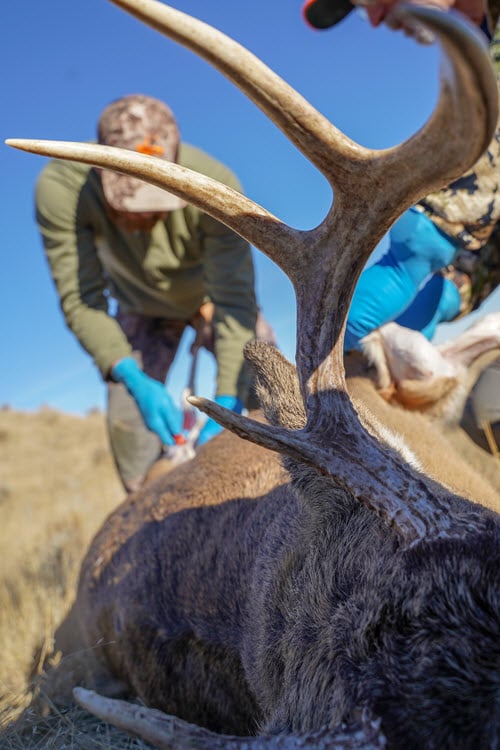
Another is incorrect or inadequate trimming. Trimming is the process during which you remove the deer’s fat, as well as all connective tissues, silver skin, and sinew. If you leave any of this in, you’ll end up with an overly gamey taste that you won’t enjoy.
Utilizing the wrong kind of processor for the meat can also lead to problems. Never skimp on the kind of processor that is used. When you bring your meat to a professional butcher, find out what kind of commercial deer processor they are using and ensure it’s good quality.
Yet another issue that can happen with venison is if you cook the meat for too long or at too cool a temperature.
Do your research before cooking venison. If this meat is new to you, don’t assume you will be able to cook it the way you do other meats. Venison has its own requirements and specifications. If venison is frozen and/or packaged in the wrong ways, there are also likely to be problems with the taste.
If you want to try venison and decide to buy it rather than trying to hunt and prepare it yourself, buy it from a store known for its excellent game meat. Ask questions about how the deer was hunted and prepared so that you know you will get a delicious cut of meat.
Eating Venison Can Help the Environment
When deer are hunted in a humane and sustainable way that is in line with local laws and regulations, it can be a help to the biosystem. That is because without hunters, it’s possible for deer populations to become too large and become a strain on vegetation.
Too many deer and not enough browse can also cause a high percentage of the deer population to starve in harsh winter conditions.
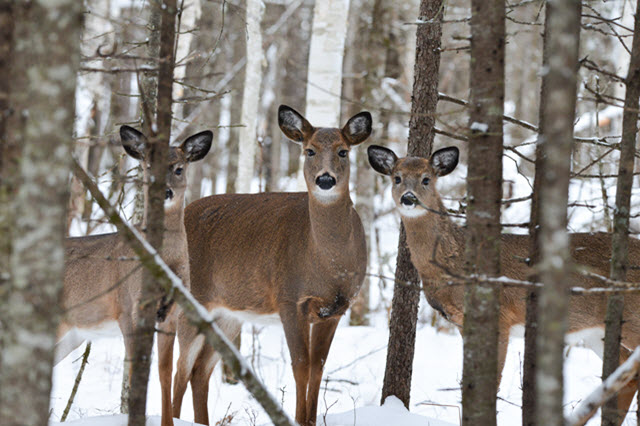
This can throw the entire habitat out of balance.
Also, when you eat venison instead of beef, you’re not supporting industrial agricultural operations that hurt the environment.
How Does Venison Differ from Beef
As mentioned, venison has a moderately gamey taste that is completely absent from farm animal meat, such as beef. Venison is lower-fat than beef, and it’s richer in minerals and vitamins beneficial to the human body.
When you have venison from wild deer, you also enjoy the benefits of eating the meat of an animal that has only eaten natural foods and lived in a natural, healthy environment. With beef produced on industrial farms, you don’t enjoy that benefit.
As a meat with many differences to beef, you shouldn’t cook venison in the same way as you do meat from cows. Let’s go over some of the cooking tips that work especially well with venison.
Fat-Removal is Incredibly Important
While removing the fat from beef is a matter of preference, fat-removal with venison is essential. If you leave fat on venison, you’ll end up with an intensely gamey flavor that you certainly won’t like. You will also notice your mouth has a strange coating after eating that most people find quite disgusting.
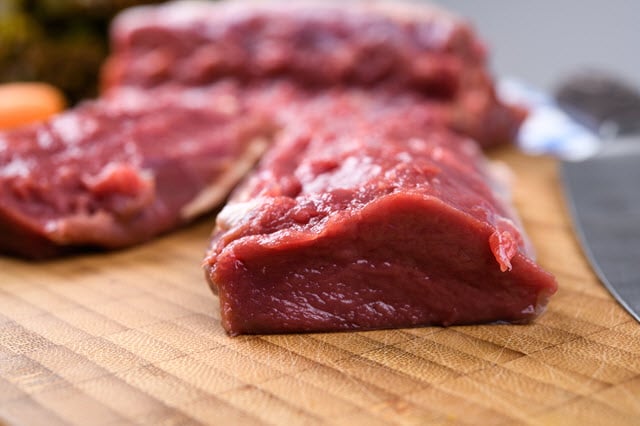
Remove all the silver skin as well as the fat from your deer meat.
Thick Slices are Best
Never cut venison too thin. If you do, it can quickly overcook. This will result in dried out meat. Your venison should get to around 145 degrees Fahrenheit for it to be cooked. There will be a little bit of pink in the middle. When you get the cooking right, your venison should have a little moisture. Venison that is cut too thinly will end up being dried out and extremely tough to chew.
Marinade is Important
Always use marinade when cooking venison. This is necessary because of how easily venison dries out. Give your venison several hours to marinate prior to cooking. Some people even like to leave it marinating for a full day. Marinating your venison will make sure it stays juicy.
Venison Cuts of Meat
Like with any other kind of meat, venison has a number of different parts and cuts. Some of the most popular are:
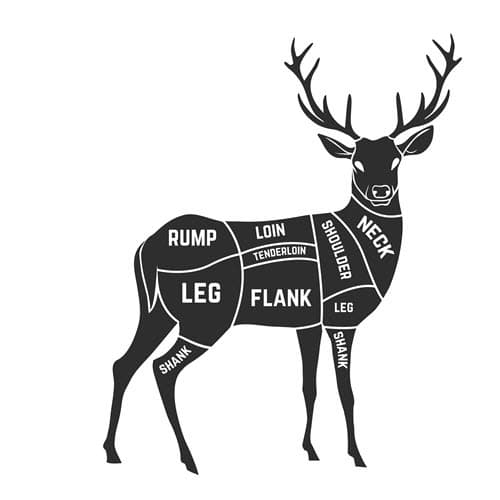
- Tenderloin
- Backstraps
- Shoulder
- Haunch
Tenderloins: One of the most popular venison cuts is the tenderloins. These are the smallest cut of venison, and they’re the most tender part of the deer’s body.
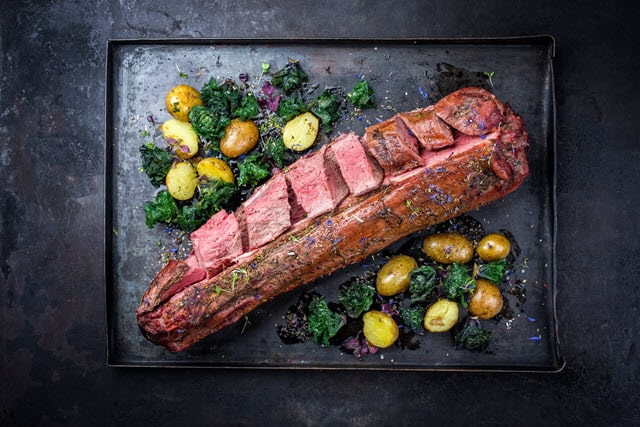
If you have venison tenderloins that you’d like to cook, keep the recipe simple. Perhaps use some butter in cooking, adding a bit of pepper and garlic. In general, this cut of meat does best when you use high heat and do fast cooking.
Backstraps: A wonderful way of cooking backstraps is to wrap them in bacon. This is a popular dish that most venison-fans will know and love.
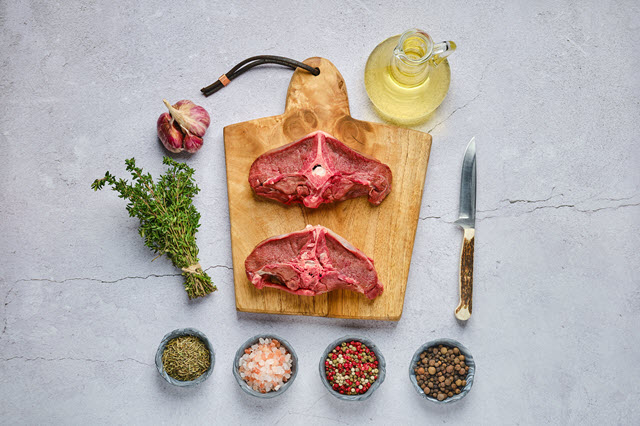
Shoulder: Most people will cut the shoulder up into small pieces and use it for venison stew.
Haunch: The deer’s haunches are great if you want to make a venison recipe that requires the presence of bone. This kind of cut is referred to as “bone-in-joint.”
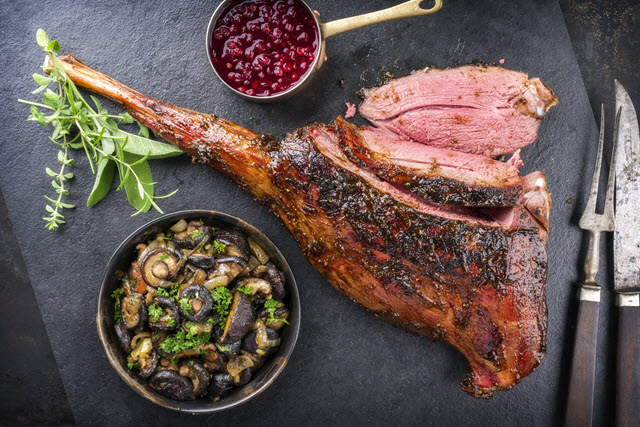
Most of the time, however, the bones are removed and the meat is used for steaks.
Enjoy The Unique Taste of Venison
Venison is a nutritious and versatile meat that you may want to try. If you’ve never had it, we recommend that you keep an open mind and try this game-meat at least once. You just might fall in love.

